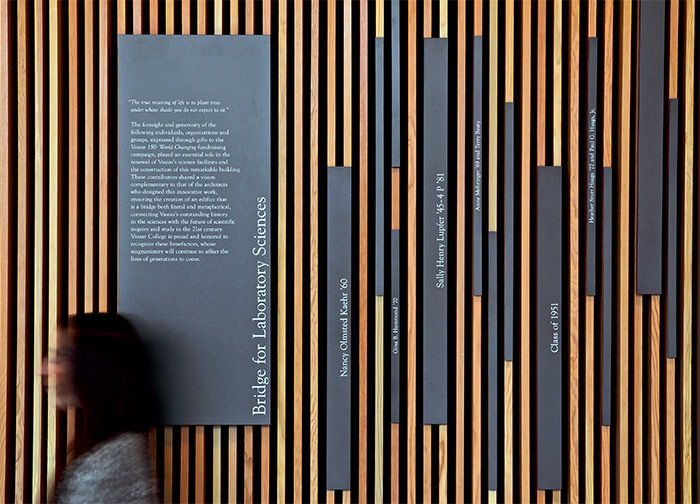
June 2016
Poulin + Morris Develop Environmental Graphics, Donor Recognition, and Wayfinding for a Building that Brings Science at Vassar into the 21st Century
Science has always played an essential role in education at Vassar College; the first faculty member was an astronomer. But for years, the various science departments have been scattered across the campus in aging facilities, but no longer. The 157,000-square-foot Integrated Science Commons, designed by Ennead Architects, is composed of both new and renovated buildings, creating a cohesive and vibrant science community while providing state-of-art teaching and research laboratories for students and faculty. The centerpiece of the project, The Bridge, is a newly constructed, 82,000-square-foot, LEED-Silver certified building equipped with the latest scientific equipment and resources including a robotics lab, an earth and environment lab, visualization lab, fabrication facility, café, outdoor patio, and open common spaces. As its name suggests, The Bridge serves as a link to the other recently renovated science buildings—Olmsted Hall, New England, and Sanders Physics, fostering collaboration across the College’s science curriculum.
Poulin + Morris developed a comprehensive environmental graphics, donor recognition, and wayfinding sign program for the Commons which includes building, public space, laboratory, lounge, and classroom identification, as well as directional, informational, and regulatory signs relating to building, health, accessibility, fire, and ADA codes. Located in The Bridge building’s main entrance lobby, a donor recognition wall features vertical panels that align with the wooden slats of a 16-foot-long wall and display individual donor names. “Our goal with the donor recognition wall was threefold,” said Richard Poulin, Co-founder, Design Director and Principal at Poulin + Morris. “To utilize the lobby’s distinctive ribbed wood wall in an intriguing way; to acknowledge those who made the entire project possible, the donors, at different levels; and to create something dynamic, that portrays the constant forward motion of science.”





